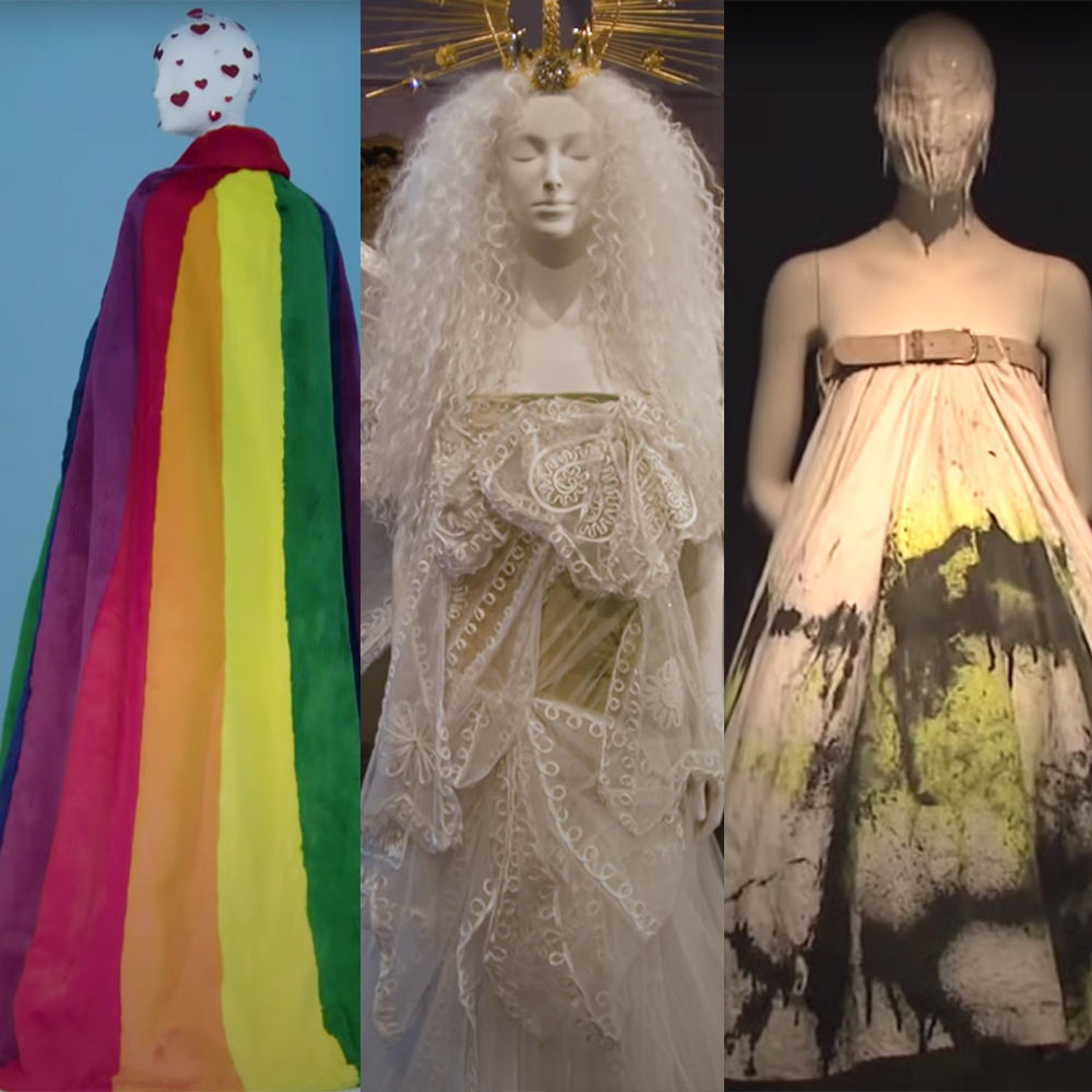To celebrate the opening of this year’s spring Costume Institute exhibition, In America: An Anthology of Fashion, we’re looking back at some of The Met’s most iconic fashion shows through a collection of virtual tours dating back to 2010. Presenting seminal exhibitions such as Alexander McQueen: Savage Beauty (2011) and Heavenly Bodies: Fashion and the Catholic Imagination (2018), these tours provide us with a decade of stunning fashion displayed in dreamlike spaces. If you missed any of these blockbuster shows, want to learn more about a particular designer, or are hoping to revisit old favorites, then take a look at the selections below.
About Time: Fashion and Duration
In conjunction with The Met’s 150th anniversary, The Costume Institute’s spring 2020 exhibition traced a century and a half of fashion, from 1870 to 2020. With Virginia Woolf serving as the “ghost narrator,” a disrupted timeline unfolded in the form of two adjacent clock faces. Each “minute” of the clock featured a pair of garments connected through silhouette, technique, and embellishment. Each pair exemplified both fashion’s linear progression and its cyclical impulses. This conflation of fashion’s temporal character represented Henri Bergson’s concept of duration, or the ways in which the past and the present coexist.
Camp: Notes on Fashion
Susan Sontag’s seminal 1964 essay “Notes on Camp” provided the framework for The Costume Institute’s spring 2019 exhibition, Camp: Notes on Fashion. Camp’s semantic lineage is traced through a canon of heroes and heroines of queer culture, outlining the origins of this extravagant aesthetic. Through more than 250 objects dating from the eighteenth century through the present, the exhibition celebrated notions of irony, theatricality, exaggeration, and pastiche in fashion.
Heavenly Bodies: Fashion and the Catholic Imagination
Heavenly Bodies: Fashion and the Catholic Imagination explored fashion’s engagement with the devotional practices and traditions of Catholicism. Fashions from the early twentieth century through the present were shown in dialogue with Medieval artworks from The Met collection. Additionally, papal garments from the Sistine Chapel were displayed in the Anna Wintour Costume Center, many of which had never been exhibited outside of the Vatican.
Rei Kawakubo/Comme des Garcons: The Art of the In-Between
The Costume Institute’s spring 2017 exhibition examined the work of designer Rei Kawakubo, the department’s first monographic show on a living designer since 1983. Staged as an artistic intervention, Kawakubo’s challenges of conventional fashionability were explored through 140 examples of womenswear from the 1980s through 2017. The exhibition focused on nine dualities—or expressions of “in-betweenness”—in Kawakubo’s collections: Absence/Presence; Design/Not Design; Fashion/Antifashion; Model/Multiple; High/Low; Then/Now; Self/Other; Object/Subject; and Clothes/Not Clothes.
Manus X Machina: Fashion in an Age of Technology
The Costume Institute’s 2016 exhibition Manus X Machina: Fashion in an Age of Technology addressed how fashion designers reconcile the handmade and the machine-made in the creation of haute couture and ready-to-wear clothing. The Robert Lehman Wing was transformed into a building-within-a-building, using white scrim to evoke the clinical interior of a laboratory or atelier. Within the space, case studies based on the métiers in Diderot’s Encyclopedia analyzed the hand- and machine-based techniques of the garments on display and challenged the conventions of the hand/machine dichotomy.
China: Through the Looking Glass
In a collaboration between The Costume Institute and the Department of Asian Art, the 2015 exhibition China: Through the Looking Glass explored how Chinese aesthetics have fueled the imagination of Western designers for centuries. High fashion was juxtaposed with examples of Chinese Imperial dress, decorative arts, and cinema as a reflection of China’s image within Western visual culture.
Charles James: Beyond Fashion
Charles James: Beyond Fashion presented a sweeping retrospective of the legendary Anglo-American couturier. The exhibition examined James’s scientific, architectural approach to design and how it informed his innovative draping and tailoring techniques. X-rays, analytical animations, and vintage images helped illuminate the history and revolutionary construction of some of James’s most iconic gowns, including the “Clover Leaf,” “Lobster,” and “Swan.”
PUNK: Chaos to Couture
The Costume Institute’s spring 2013 exhibition examined punk’s lasting impact on high fashion from its origins in the 1970s through the present. Focusing on the relationship between the punk concept of “do-it-yourself” and the couture concept of “made-to-measure,” the exhibition was organized around the materials, techniques, and embellishments associated with the anti-establishment style.
Alexander McQueen: Savage Beauty
The Costume Institute’s spring 2011 exhibition examined the late Alexander McQueen’s extraordinary contributions to fashion. An iconoclast of his generation, McQueen’s approach was akin to that of an artist, using fashion as a medium to express complex concepts of identity, politics, and culture. Featuring approximately one hundred ensembles and seventy accessories, Alexander McQueen: Savage Beauty celebrated the nineteen-year career of one of fashion’s most evocative storytellers.
American Woman: Fashioning a National Identity
American Woman: Fashioning a National Identity explored the developing notion of the modern American woman from 1890 through 1940. Archetypes of a distinctly American femininity such as “Gibson Girls” and “Screen Sirens” illustrated how these style revolutions laid the aesthetic foundations for women in the United States today. Notably, this exhibition was the first Costume Institute show drawn from the Brooklyn Museum Costume Collection at The Met.
